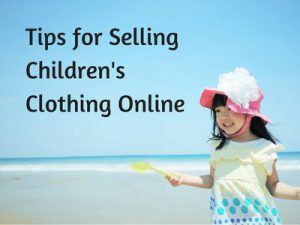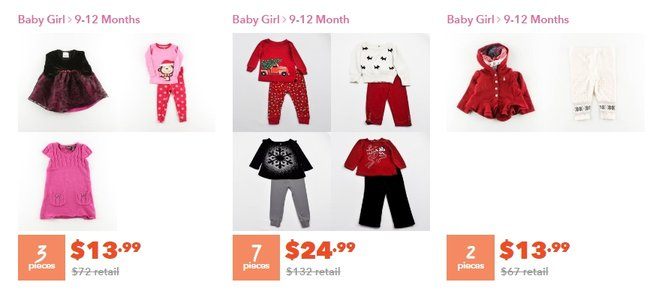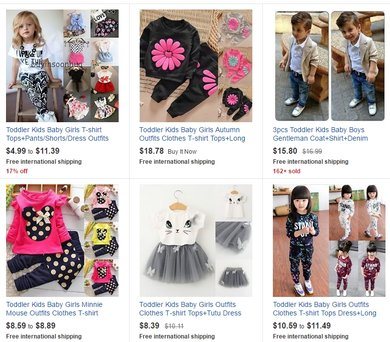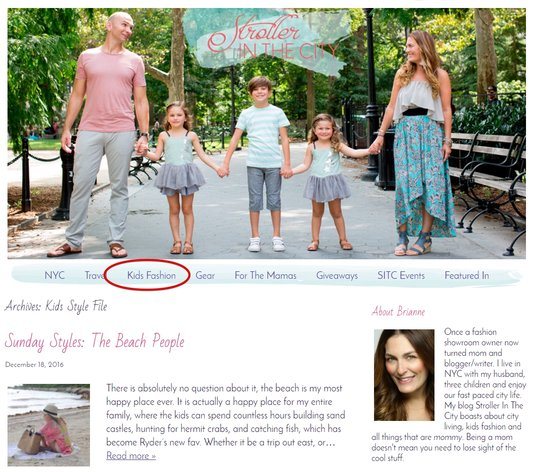 Whether you are a stay at home mom, a shop owner, or simply someone who’s interested in children’s wear, you’ve come to the right page to learn about how to sell children’s clothing online. In this week’s article, I am going to explore some of the common techniques out there and find out the potential profit that each of them can generate.
Whether you are a stay at home mom, a shop owner, or simply someone who’s interested in children’s wear, you’ve come to the right page to learn about how to sell children’s clothing online. In this week’s article, I am going to explore some of the common techniques out there and find out the potential profit that each of them can generate.
Hopefully, by the end of this article, you’ll be able to find something that works for you.
1) Sell Used Clothing
Clothing reselling sites are becoming quite popular nowadays. What started with mostly women and men’s wardrobe listing has now found its way to children’s collections as well. Generally, this is how it works.

You pick a reselling website, order a consignment package, pack the clothings and deliver them back to that company. They would then examine the items to make sure that everything is clean and cared for before listing them on the website. When the item is sold, the profit will be shared between you and the company based on the terms and conditions.
Pros – Not much effort is actually required on your side. You just need to make sure that the clothings are in good condition before you ship them over.
Cons – Most of these second hand items are sold at fairly low prices, somewhere less than $10. So you can’t expect a high profit margin from the sale. When the item cannot sell after a period of time, you need to decide whether you want them to be shipped back to you or allow the company to donate to charity, in which you will not earn anything.
Another disadvantage is that you run the risk of losing a listing place if the company decides to discontinue the reselling service.
Profit potential – Minimal and uncertain.
2) Online Marketplace
I am sure you have seen a lot of eCommerce stores selling children’s clothing, whether it is on a big marketplace like Amazon or some XYZ platform from your local search. Regardless of the size, these stores have one thing in common; they need to be registered as a business before they can operate legally online.
They need to get a sales tax license, Employer Identification Number and set up a business bank account in order to receive any payment online. After sorting out this complicated process, you need to proceed with two things 1) Source for your inventory and 2) Select an eCommerce platform.
Inventory
There are basically two ways to acquire them; buy them from wholesalers OR engage with suppliers that do drop shipping. This step is crucial because the quality of your products and the efficacy of your customer service greatly depend on who you choose to work with.
Even if it means flying to another country to meet the suppliers face-to-face and checking their products, that’s probably what you have to do too.
Ecommerce Platform

Again, there are also two ways to go about this; list on popular eCommerce sites such as eBay or create your own online store with WooCommerce. The main difference here is that with eCommerce sites, you can piggy back on the pre-existing traffic to sell your items while with your own platform, you need to build your own unique traffic and this could take months.
Pros – You have better control over your own marketing channels.
Cons – The whole process can be quite laborious and cost intensive and the return on investment might not always be what you expect. If you choose to buy and sell for example, you face the risk of overstocking if your clothings run out of trend. If you choose to sell on popular sites, you’ll need to pay for listing fees and compete with hundred over stores that are selling the same kind of products as you.
And here’s a little tip to help you understand a bit about online traffic.
Nowadays, eCommerce stores don’t rank very well on the search engines unless 1) your store belongs to a giant brand like Amazon or 2) you pay for your business to show up on the search results. When you are just starting out, I am guessing that you are neither the two. So, there’s a lot to think about on how to get people to buy from you after you’ve setup your online store.
Profit potential – Moderate and high risk.
3) Affiliate Marketing
In this third technique, you earn from sales commissions through affiliate programs offered by clothing companies. A lot of big brands are adopting this marketing system because it offers a more personal approach for online shoppers as compared to those overcrowded eCommerce platforms.
Where promoting physical item is concerned, these companies usually require you to have a website up and running with some relevant content before accepting you into their programs. This process can help them to verify your identity and also your commitment as a business owner.

Now, your website don’t necessarily have to be 100% about children’s clothing. You can create a mommy blog, a parenting blog, a photography blog WHILE recommending the latest kids fashion. It’s all about being creative without re-creating too much eCommerce experience for your visitors.
People who read blogs/websites are usually looking for helpful information and product reviews so what they want to see is more engaging content instead of someone trying to push them products.
Even if you are only discussing about one or two types of clothings, you’d be surprised how this could actually attract more people who are interested in buying an item through your recommendation.
Just to show you how much opportunities there are in this niche, I’ve listed some affiliate programs and their commission payout.
- Gymboree – 8% (via ShareASale)
- Tea Collection – 8% (via ShareASale)
- Janie and Jack – 8% (via ShareASale)
- My Little Jules – 7%
- Crazy 8 – 8% (via ShareASale)
- Zappos – 9% (via Commission Junction)
- Carhartt – 4% (via Commission Junction)
- Amazon – 4% (via Amazon Associate)
Pros – With affiliate marketing, there are no inventories to manage. You only need to maintain a domain and website hosting fees which makes it very easy to start an online business. You can choose to partner with several companies, thus adding to your income streams.
When it comes to online ranking, a good blog will always surpass the content coming from an eCommerce site because search engines are now getting better at delivering information first before product listings.
Cons – You need to publish content regularly to build good quality traffic to your site. This could take some time before you generate a decent income.
Profit potential – Highly profitable and low risk.
The Best Technique for Long Term Profit
By comparing these three business models, I think it’s quite obvious which technique is the winner here when it comes to selling children’s clothing online as a beginner.
You can tell that I am a big advocate for affiliate marketing because it’s flexible and doesn’t cost a lot to start up. However, I would encourage that you do a bit of learning first so that you get a good foundation and experience better results from your effort.
Read more about why I choose this platform as my preferred training for affiliate business.
Do you have any thoughts or questions about this topic? Feel free to leave them in the space below and I’d be happy to respond.
You may also be interested to read;
6 Recommended Affiliate Programs for Stay at Home Mom

I make handmade little girls clothing and they are very cute. I’m currently on Etsy. Got some views, but no sales. Seems like a slow process. Etsy has so many people selling there and I feel like a little fish in a big ocean. What can I do to improve my selling? Thanks.
Hey Sandra, the problem with using crowded marketplaces like Etsy is that it’s hard to get noticed among other sellers who are more established. A quick search for ‘handmade girl dress’ gives us more than 36 thousand results – that’s a lot for the shoppers to filter and there’s no way to control the product listing unless you sign up for Etsy’s promoted listing which requires a certain amount of budget. Even if you do get a targeted audience, you need to include a lot of details for engagement in order to convert readers into shoppers.
There are many successful sellers who share about these tips online so it’s not an impossible feat. In my opinion however, you should start to create your own online presence from the beginning, if your product is of values. Build your own custom website, set up an online store and learn to get traffic from the search engines where there are more keyword opportunities to target.
Handmade products are in good demand, but as a beginner, don’t place yourself next to a big competitor. Having your own store will set you apart from most sellers and allow your online business to grow even more.
Right now I mainly do re-selling of children’s clothes, since my kids are growing so fast it seems like they need new clothes every single week. You offer an interesting option in affiliate marketing for children’s clothes. I LOVE Gymboree and have been buying their clothes since my kids were babies. I might have to check into that. Thanks for sharing!
Hi Cathy,
Interesting read – the different ways to sell clothing online. Having your own store is possible, but overheads for used clothing would make it hard to make much profit. The time to pack and ship low cost items would mean low profits.
I agree that the best ‘model’ is affiliate marketing which is low in costs and has more potential reward.
Thank you for this article. My girlfriend is working on opening an eCommerce store which she will be selling baby clothes. Unfortunately, she is a nurse so she needs a lot of information on ideas and techniques to succeed in her plans. Very nice informative article. Will forward this article to her.
Thanks for the post. Surprised that I’m a dad and looking at your post with interest. My kids mum (my wife)’s the one who does the shopping for clothes for my kids. Anyway I like the various way to sell children’s clothing online as I apply it to what I’m doing with my own business.
I started with #1 selling used and its been great. Then I went to #2 of eCommerce, but I have to say I agree with you on the higher risk as it didn’t work for me. Now I’m doing #3 affiliate marketing and hope it’ll bring better results.
I didn’t realize there was such a market for online children’s resellers. I usually just donate everything to my local goodwill. Kids grow out of clothes so fast, and this is a great idea to get a little something back. We have literally bought something out of season, hoping it would fit next season, and wouldn’t you know it, it doesn’t fit. Sometimes we donate items that still have the tags on them. I need to look into reseller sites. Thank you for the informative article.